13 Deck Railing Ideas FOr Your Outdoor Space!
Picture a perfect summer night, a cool drink in your hand, and a soft breeze moving through the trees. There’s something special about hanging out on your deck, but to really make it shine, you need more than just a plain area. That’s where deck railings come into play. They offer safety and bring personality and flair to your outdoor area. In this article, we’ll look at 17 great deck railing ideas that will enhance your backyard haven. So, let’s dive in!
1. Aluminum Railing
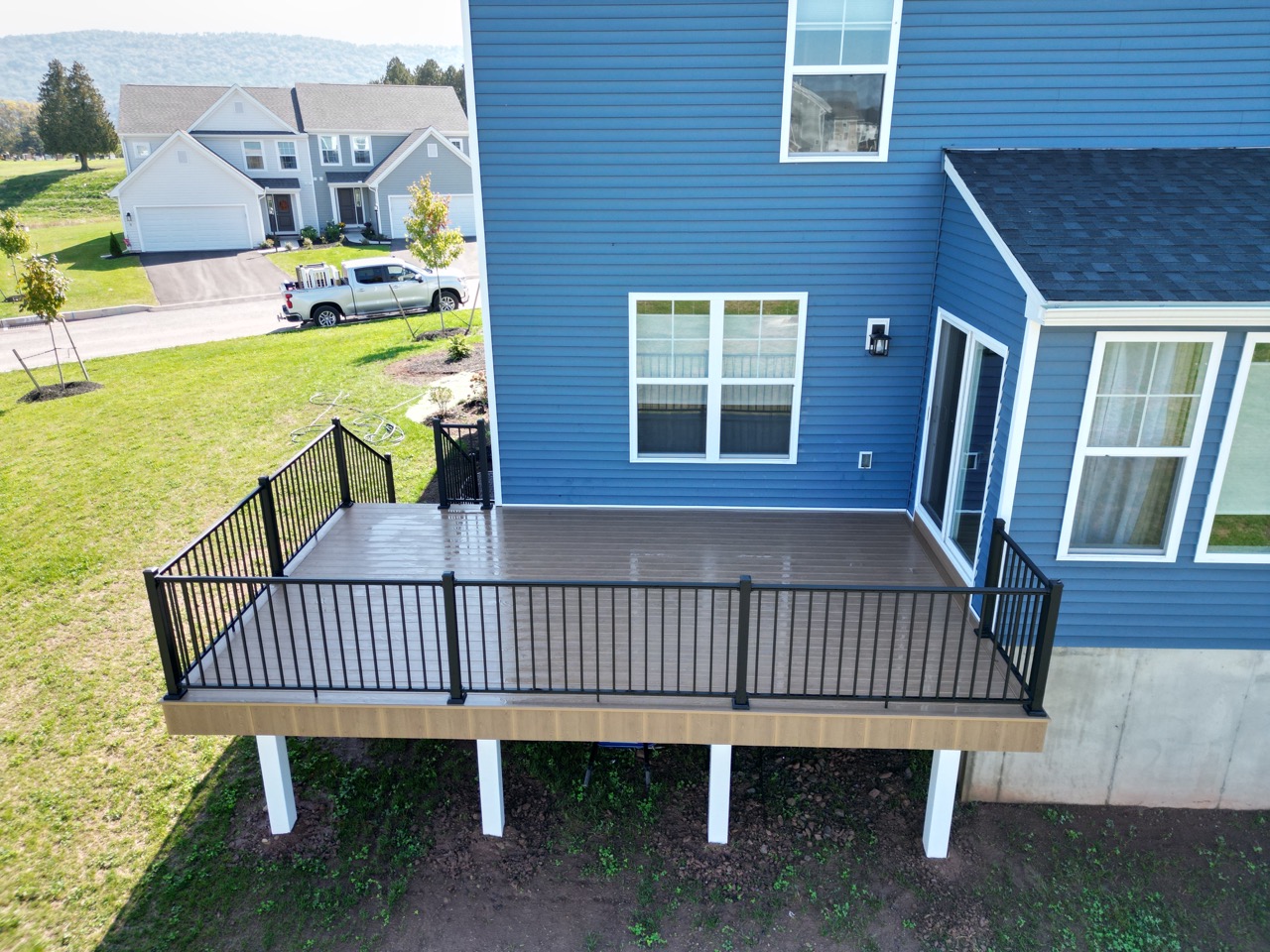
Do you want a clean, modern look with a long life span? Aluminum railing is the way to go! Aluminum may not be the first thing that comes to your mind, but it has grown more popular in the last several years. There are many styles of railing available. For example, Keylink has three different series and multiple baluster styles. Here are some aluminum deck railing ideas you can use for your deck design.
Pros Of Aluminium Railing
Durability and Maintenance: Aluminum railings are highly durable and resistant to corrosion, which makes them suitable for harsh weather conditions and coastal areas where salt can be a problem. Unlike wood, aluminum does not rot, warp, or require frequent painting or staining, which significantly reduces maintenance efforts and costs.
Customization Options: Aluminum railings come in a variety of styles and finishes, including powder-coated options that can mimic the look of wrought iron or blend seamlessly with modern architectural styles. This flexibility allows homeowners to match the railing with their home’s exterior and personal taste.
Cons Of Aluminum Railing
Cost: Aluminum railings generally cost more than other materials like wood or vinyl. The initial investment can be significant, although it might be offset over the long term by lower maintenance costs and longer lifespan.
Thermal Conductivity: Aluminum conducts heat and cold, which means it can be hot to the touch in sunny climates or uncomfortably cold in winter conditions. This can make it less comfortable to use compared to materials like wood, which do not conduct temperature as quickly.
American Series

The American Series features a flat top, textured finish, and clean profile. It is available in 6 colors, or you can special order a custom color. We recommend this series because it is made of thick-walled aluminum, has vinyl inserts to prevent rattling, and is easy to install.
Chesapeake Series

The Chesapeake Series is perfect if your outdoor living area is designed to entertain friends and family. The top rail is convenient for resting cups, plates, or other food utensils. You can customize the rail by adding a color-coordinated top rail to match the deck. Check out the drink rail section below if you want to drink railing ideas.
Outlook Series

The Outlook Series is smooth and slim. It is ideal for homeowners who are looking for low-profile deck railing ideas. Like the other products from Keylink, it is easy to install and contains vinyl inserts to prevent rattling. It is available in six standard colors.
2. Cable Railing
Horizontal Cable Railing

Cable Railing uses cable inlay instead of balusters. If you are looking for deck railing ideas but want a relatively unobstructed view, cable railing is the way to go. Keylink has one of the easiest systems to install. You can buy horizontal cable railing in the American Series or the Chesapeake series. The cable and fittings are made of marine grade 316-grade stainless steel and have predrilled holes in the posts. This allows you to install the cable around corns and down steps without extra posts. Just tighten the cable at the fittings, and you will be good to go!
Vertical Cable Railing
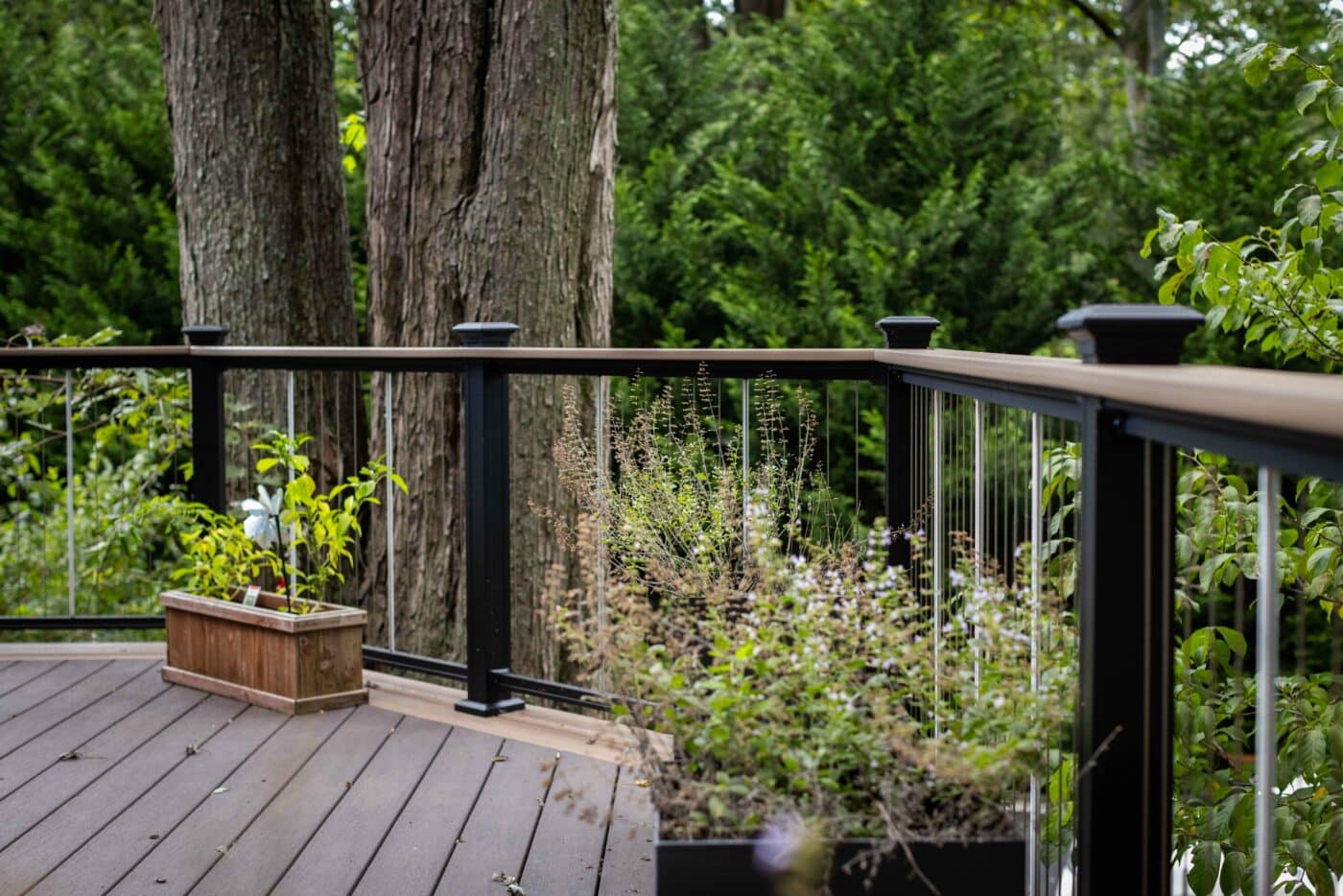
Vertical cable railing has the same benefits as horizontal railing. It features stainless steel support rods that blend in with the cable and give extra rigidity to the top and bottom rails. The railing comes in preassembled sections, allowing for easy installation.
Pros of Cable Railing
Unobstructed Views: Horizontal cable railings are less obtrusive than traditional picket-based systems, providing a clearer view of your surroundings. This feature is especially beneficial in scenic locations where you might not want the view interrupted by more opaque railing materials.
Modern Look: Cable railings’ clean lines and minimalistic design can significantly enhance a deck’s contemporary look. This style can blend well with modern and traditional architecture, offering a subtle yet striking feature.
Cons Of Cable Railing
Safety Concerns for Children and Pets: The horizontal cables can act as a ladder, allowing children or pets to climb the railing, which could increase the risk of falls. Additionally, the gaps between cables can be wide enough for small pets to slip through, which might not be ideal for all homes.
Maintenance and Durability: Cable railings require regular tensioning to maintain safety and aesthetics, as the cables can sag over time. They may also require more maintenance in harsh.
3. Vinyl Railing
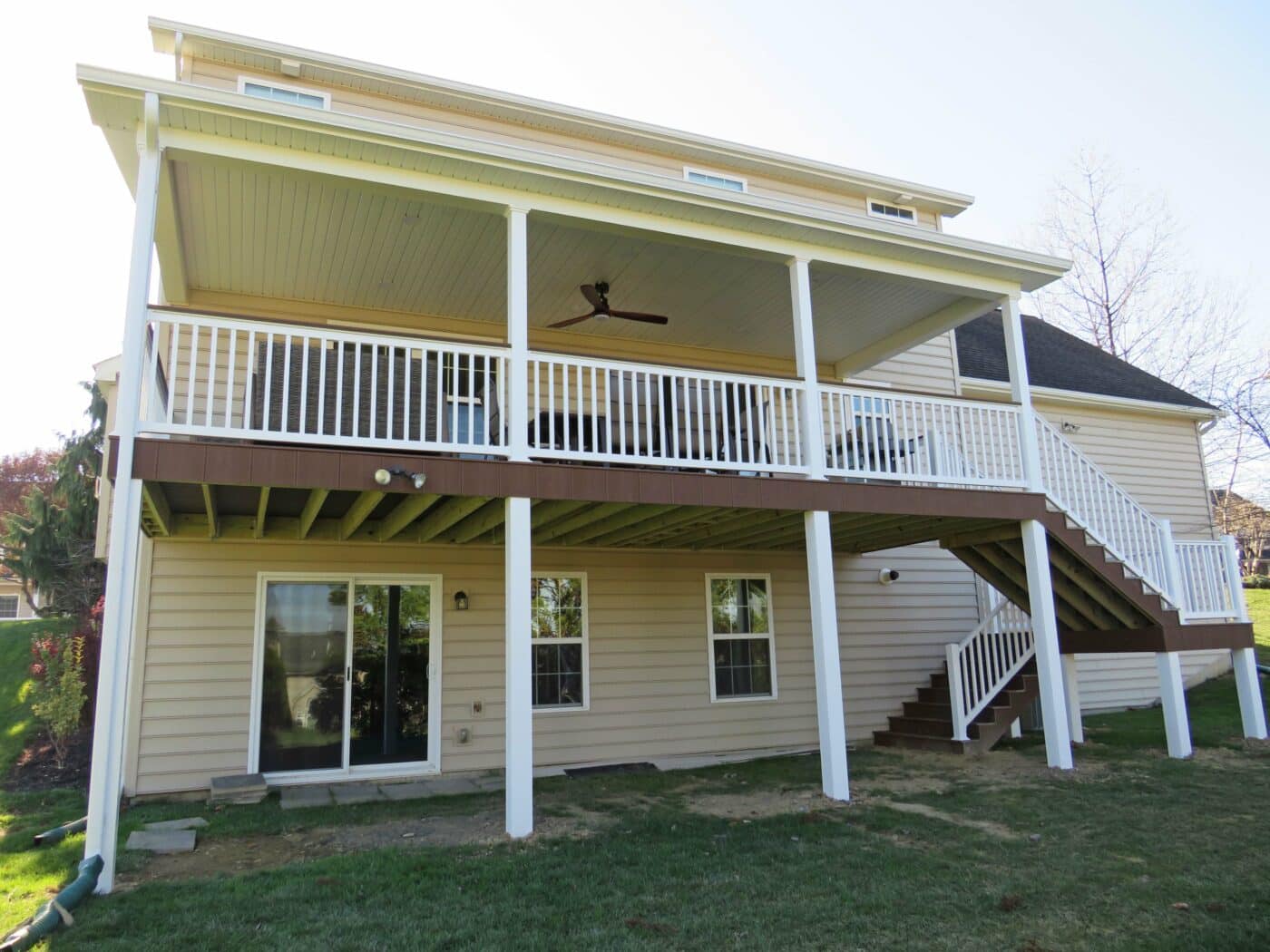
Vinyl railings have three main advantages.
Pros Of Vinyl Railing
Low Maintenance: Vinyl deck railing is very popular because it requires little maintenance. Unlike wood, it doesn’t require painting, staining, or sealing, and it’s resistant to rot, decay, and insect infestation. You typically only need to clean it with soap and water to keep it looking new.
Durability: Vinyl is a non-porous material that resists weathering and everyday wear and tear. It doesn’t splinter, warp, or crack as easily as wood, making it a long-lasting option for deck railing.
Cons Of Vinyl Railing
Customization Limitations: While vinyl railing comes in a variety of styles and colors, it doesn’t have the same natural look and feel as wood. Some homeowners might find it too synthetic or prefer the traditional appearance and texture of wood or metal railings.
Cost: Vinyl deck railing can be more expensive initially than some other options, like certain types of wood railing. This higher upfront cost can be a con for homeowners working within a tight budget. However, the lower maintenance and longer lifespan will offset the initial investment over time.
4. Bar Railing

Check out the bar at the corner of this deck.
Did you know you can build a bar in your deck railing? If you need a place to eat, a bar or drink railing is what you need. This Trex deck built in Mechanicsburg features the Chesapeake series railing and a bar railing made from Trex decking. A bar railing is great for social gatherings and family time outside.
Pros Of A Bar Railing
Unobstructed Views: One of the main advantages of bar deck railings, especially those with thin, horizontal bars, is that they offer less visual obstruction compared to other styles, such as traditional wooden balusters. This makes them ideal for decks with scenic views.
Modern Aesthetic: Bar railings can provide a clean, modern look that is quite versatile, blending well with many contemporary home designs. Materials like stainless steel or wrought iron enhance this modern appeal and can significantly boost the visual interest of your outdoor space.
Cons Of A Bar Railing
Safety Concerns: Horizontal bar railings, in particular, can pose a safety risk as they might be easier for children to climb, leading to potential falls. This climbing issue is less of a concern with vertical bars but is still something to consider, especially in homes with young children.
Maintenance: Depending on the material, bar deck railings can require significant maintenance to prevent rust (in the case of certain metals) or decay (in the case of wood). Metal railings might need regular painting or sealing to maintain their appearance and durability, while wooden options may require staining or sealing.
5. Drink Railing
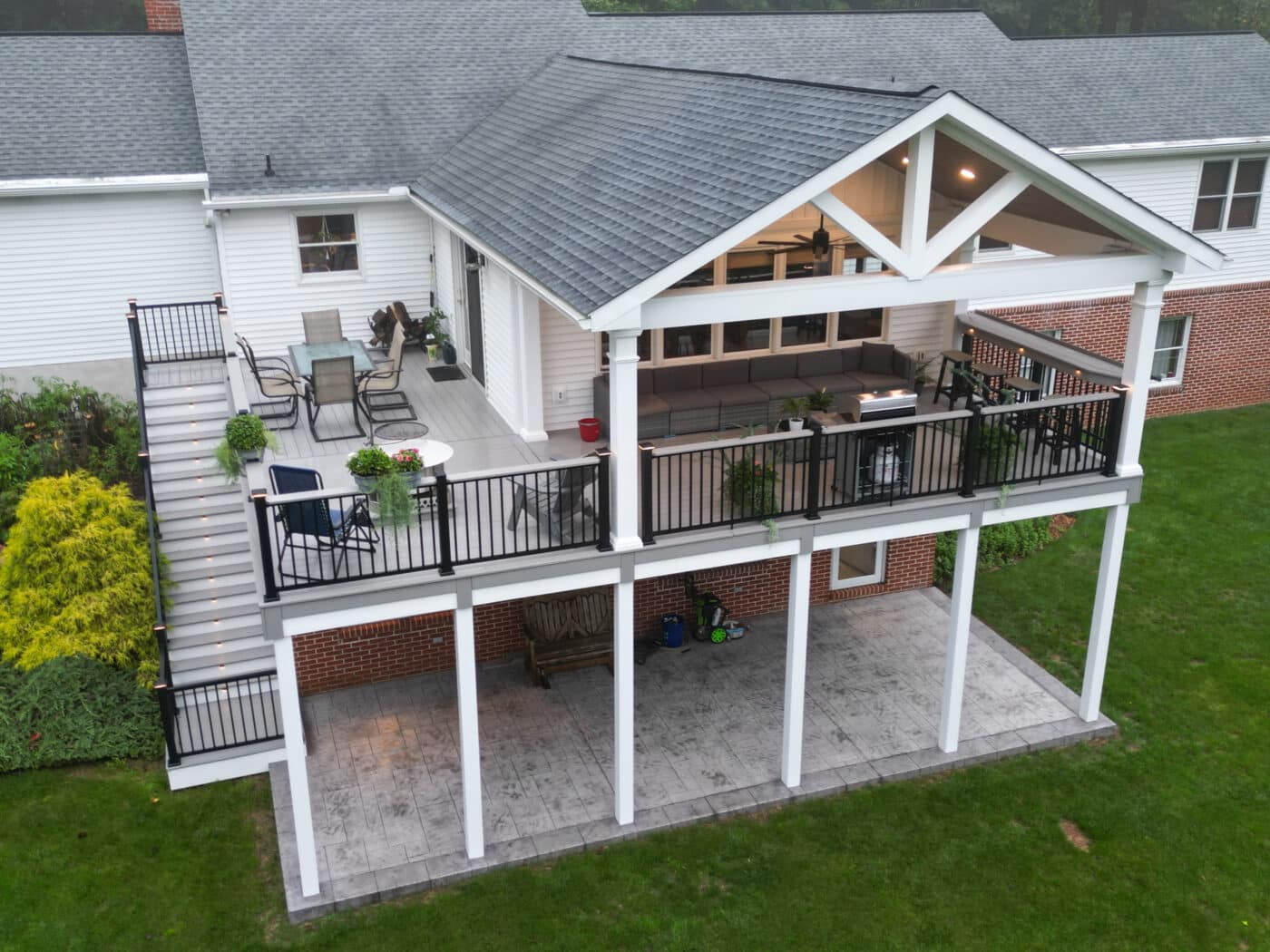
Basically, it is like a bar railing, but just one decking board is added to the top of the railing.
If you are looking for deck railing ideas that make eating outside convenient, a drink railing is a great option. The deck pictured below in Harrisburg, PA, features a Chesapeake series aluminum railing with a deck board attached as the drink rail. The decking is from Clubhouse Vinyl. This drink railing design uses the same color as the deck, cobblestone, but you can mix and match to add a cool contrast to your deck.
Pros Of A Drink Railing
Convenience for Entertainment: Drink deck railings provide a convenient place to set drinks, plates, or small personal items, making them ideal for hosting gatherings or relaxing outside. This can make outdoor spaces more usable and enjoyable, especially when entertaining guests.
Space Efficiency: By integrating the functionality of a table or a bar into the railing, these designs can help maximize the usable space on a deck, particularly in areas where additional furniture might be cumbersome or impractical.
Cons Of A Drink Railing
Safety Concerns: The flat surface of a drink railing might encourage people to sit on it, which can be unsafe if the railing is not designed to support a person’s weight. Additionally, placing items on the railing could lead to spills or accidents if they fall off, especially in windy conditions.
Maintenance Requirements: The flat surface of a drink deck railing can accumulate debris, water, and stains more easily than a standard railing. This can require more frequent cleaning and maintenance to keep it looking good and functioning well, especially if it’s used regularly to hold drinks and food. Additionally, the surface may be more exposed to weather elements, potentially leading to quicker wear and deterioration if not properly treated or constructed with weather-resistant materials.
6. Wooden Railings
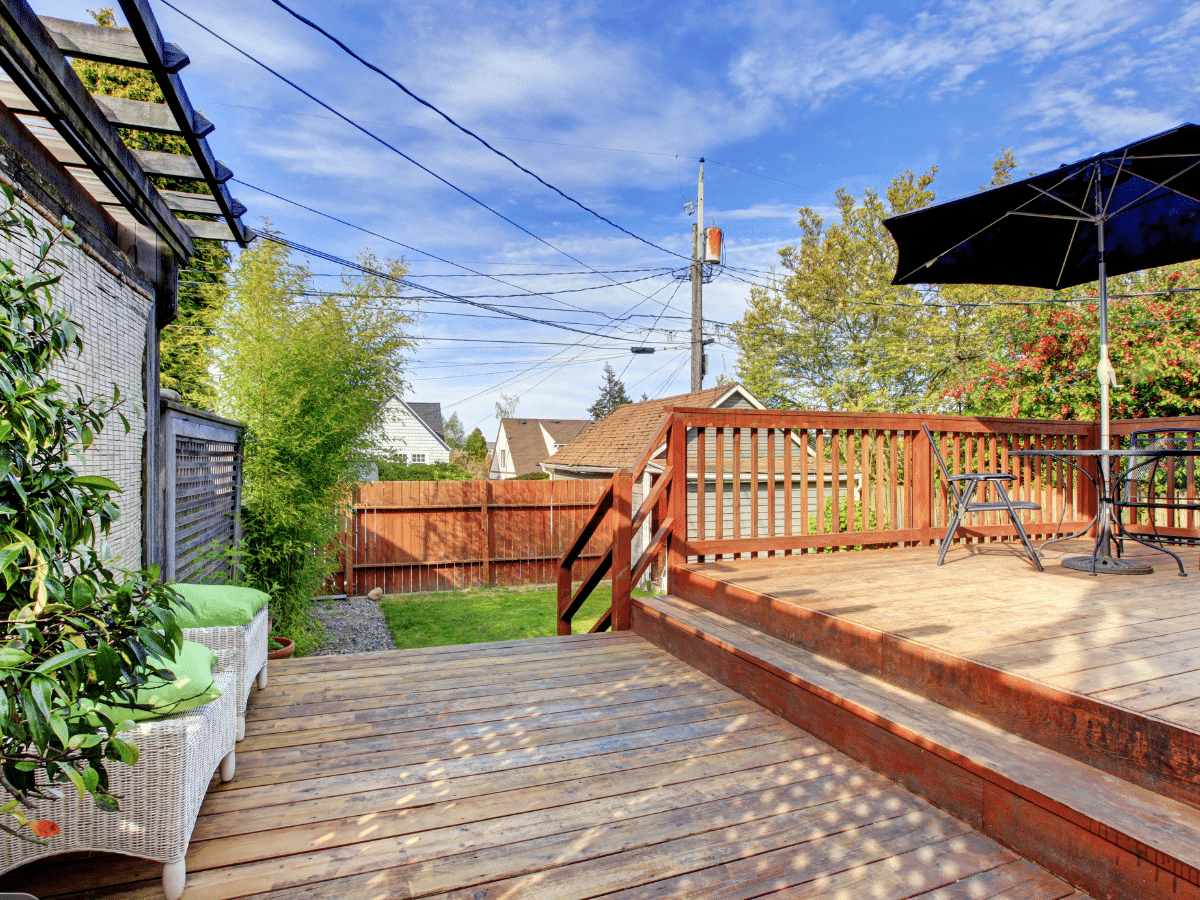
Wooden deck railings are a timeless choice. They blend seamlessly with the natural surroundings and offer a warm, rustic charm. You can opt for classic vertical pickets or get creative with horizontal designs. To make it unique, consider staining the wood in a color that complements your deck and outdoor décor. While wood can look nice for your backyard deck railing, it isn’t nearly as durable as cable deck railing or another vinyl solution.
Pros Of A Wooden Railing
Natural Look: Wooden railings blend well with the outdoors and complement most types of homes. They offer a classic, timeless appearance that can enhance the overall feel of your deck and backyard.
Customizability: You can tailor your railings to the exact style and dimensions you want. Whether you prefer a modern look or something more traditional, wood can be adjusted to meet your vision.
Cons Of A Wooden Railing
Maintenance Requirements: Wood requires more upkeep than other materials. It needs to be regularly cleaned, stained, or painted to protect it from the elements and prevent decay, warping, or insect damage.
Durability Issues: Over time, wood can suffer from exposure to moisture and sunlight. This can lead to problems such as rotting, splintering, or fading, which might require more frequent replacements compared to metal or composite materials.
7. Sleek Glass Railings

For a modern and unobstructed view of your surroundings, glass deck railings are a perfect choice. They’re especially great for homes with scenic views. These railings make your deck feel more open, and they can be customized with frosted or tinted glass for added privacy.
Cons Of Sleek Glass Railings
Maintenance: Glass railings can require more upkeep than other types, such as wood or metal. They need regular cleaning to remove fingerprints, smudges, and other marks to keep them looking clear and neat.
Cost: Glass railings are generally quite a bit more expensive than other railing options. The initial installation and the cost of the glass itself can add up, making them a higher investment.
8. Wrought Iron Railing
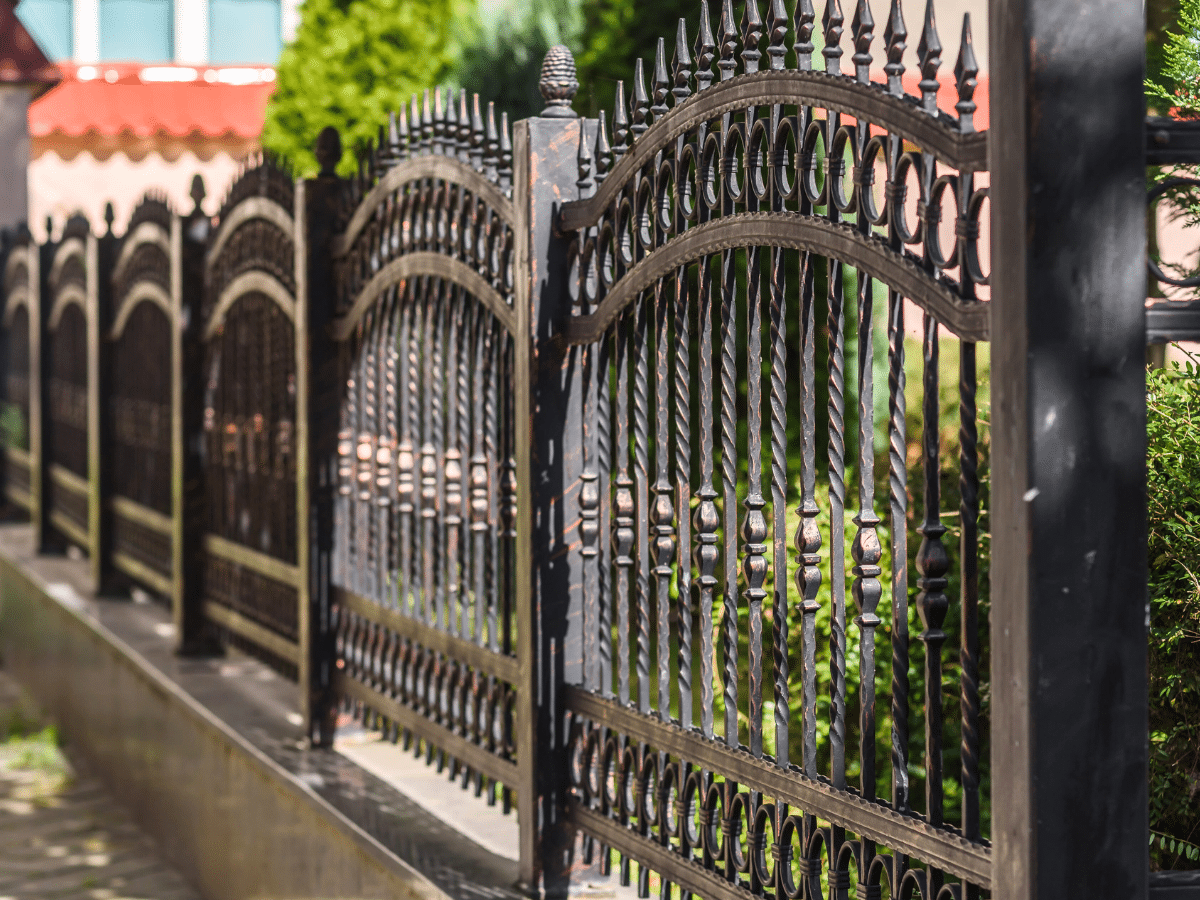
Wrought iron railings exude elegance and durability. Their intricate designs and timeless appeal can transform your outdoor space into a work of art. They are also low-maintenance and perfect for those looking for a classic, decorative touch. While iron does look nice for a while, it won’t last as long as aluminum railing. Iron has a tendency to rust after years of use, while aluminum will outlast it for years!
Pros of Wrought Iron Railing:
Durability: Wrought iron railings are incredibly strong and resistant to damage. This makes them a great choice for indoor and outdoor use, as they can withstand harsh weather conditions and don’t dent or bend easily.
Low Maintenance: Unlike some materials that need regular treatment or painting, wrought iron needs very little upkeep. A coat of paint every few years is enough to keep it looking good and to prevent rust.
Cons of Wrought Iron Railing:
Cost: Wrought iron can be quite expensive compared to materials like cable deck railing or vinyl. The initial cost of materials and installation can be high because it often requires skilled craftsmanship.
Prone to Rust: If not properly maintained, wrought iron can develop rust, especially in damp or humid climates. Regular inspections and touch-ups with paint are necessary to prevent rusting, which adds to its maintenance.
9. Composite Railing

Composite deck railings are the perfect choice if you want the appearance of wood but without the maintenance. They are made of a mix of wood fibers and plastic, providing the best of both worlds: durability and aesthetics. Plus, they come in a wide range of colors to match your style.
Mention vinyl and aluminum will be more durable. Composite still has wood inside of the board. Water can get in the ends of the board and swell it, making the boards uneven,
Pros Of Composite Railing
Durability: Composite railing is really tough. It’s made to withstand weather like rain, snow, and sunlight without breaking down or looking worn out quickly. This means it lasts a long time without needing much maintenance.
Low Maintenance: You won’t need to paint or stain composite railing every few years like you would with wood. It’s pretty much a set-it-and-forget-it option; you just need a simple wash now and then to keep it looking good.
Cons Of Composite Railing
Cost: Composite railing tends to be more expensive upfront than wood. If you’re on a tight budget, the initial cost might be too high compared to other materials.
Limited Customization: While it comes in several colors and styles, you can customize the look of the composite railing only a limited amount. If you’re looking for something specific or unique, you might find the options more restrictive than wood, which can be cut and shaped in many ways.
10. Nautical Vibes: Rope Railings
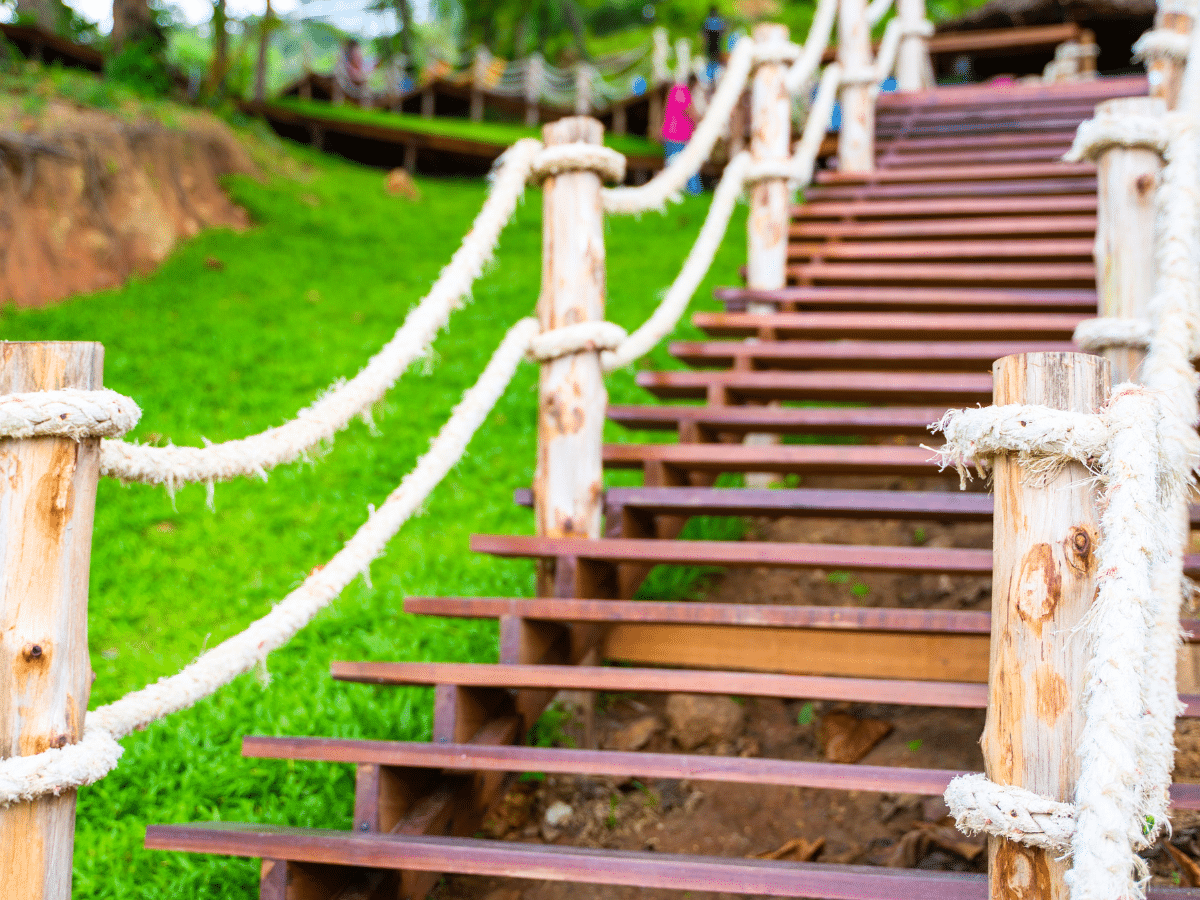
If you’re drawn to the sea and beachy vibes, rope railings can infuse your deck with nautical charm. These railings are not only visually appealing but also cost-effective. They can be easily customized and are incredibly durable.
Pros Of Rope Railing
Cost-effective: Rope railings tend to be less expensive than many other types of railings, such as those made from metal or glass. This makes them a budget-friendly option for both indoor and outdoor uses.
Easy to Install and Modify: Installing rope railings can be simpler and faster compared to more rigid materials. They offer flexibility in design and can be easily adjusted or reconfigured if your space or needs change.
Cons Of Rope Railings
Durability Issues: Rope isn’t as durable as materials like steel or aluminum. It can fray, rot, or degrade over time, especially when exposed to harsh weather conditions. This means it might need to be replaced more often than other types of railings.
Limited Support and Safety: Rope railings can offer less structural support compared to harder materials. This can be a safety concern, especially in high-traffic areas where more robust barriers are necessary to prevent falls.
11. Stainless Steel Railings
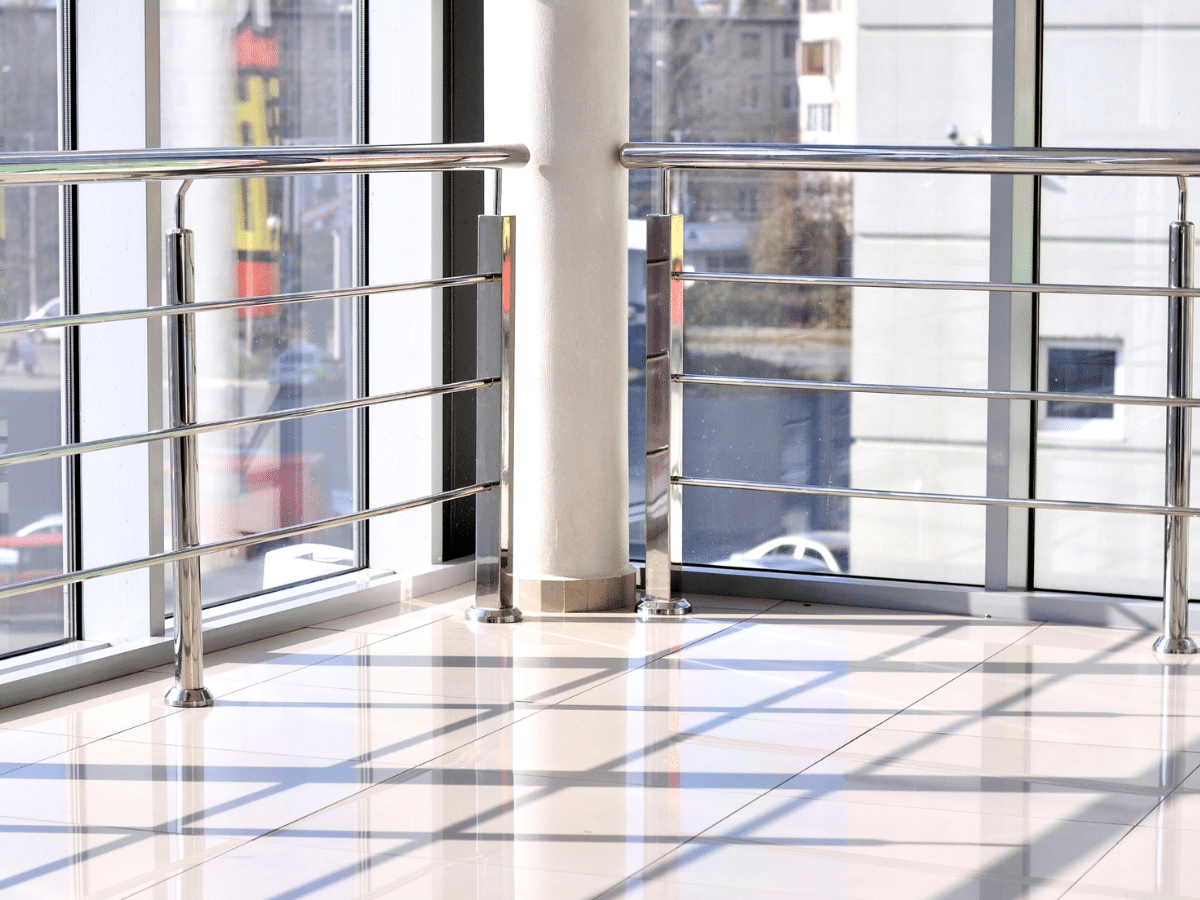
Stainless steel railings are all about sleek, contemporary style. They are resistant to corrosion, making them ideal for homes in coastal or rainy areas. The clean lines and shiny finish can give your deck a sophisticated look that’s perfect for modern architecture.
Pros For Stainless Steel Railings
Durability: Stainless steel railings are very strong and can withstand a lot of wear and tear. They don’t rust easily, which makes them great for outdoor or humid environments.
Low Maintenance: Compared to other materials, they require very little upkeep. A quick wipe down occasionally is usually enough to keep them looking good.
Cons Of Stainless Steel Railings
Cost: Stainless steel railings tend to be more expensive than those made from other materials like wood or aluminum. This initial higher cost can be a downside for some budgets.Shows Smudges and Fingerprints: While they’re easy to clean, stainless steel surfaces can show fingerprints and smudges more readily, which might require more frequent cleaning to maintain a spotless look.
12. Deck Railing Lighting
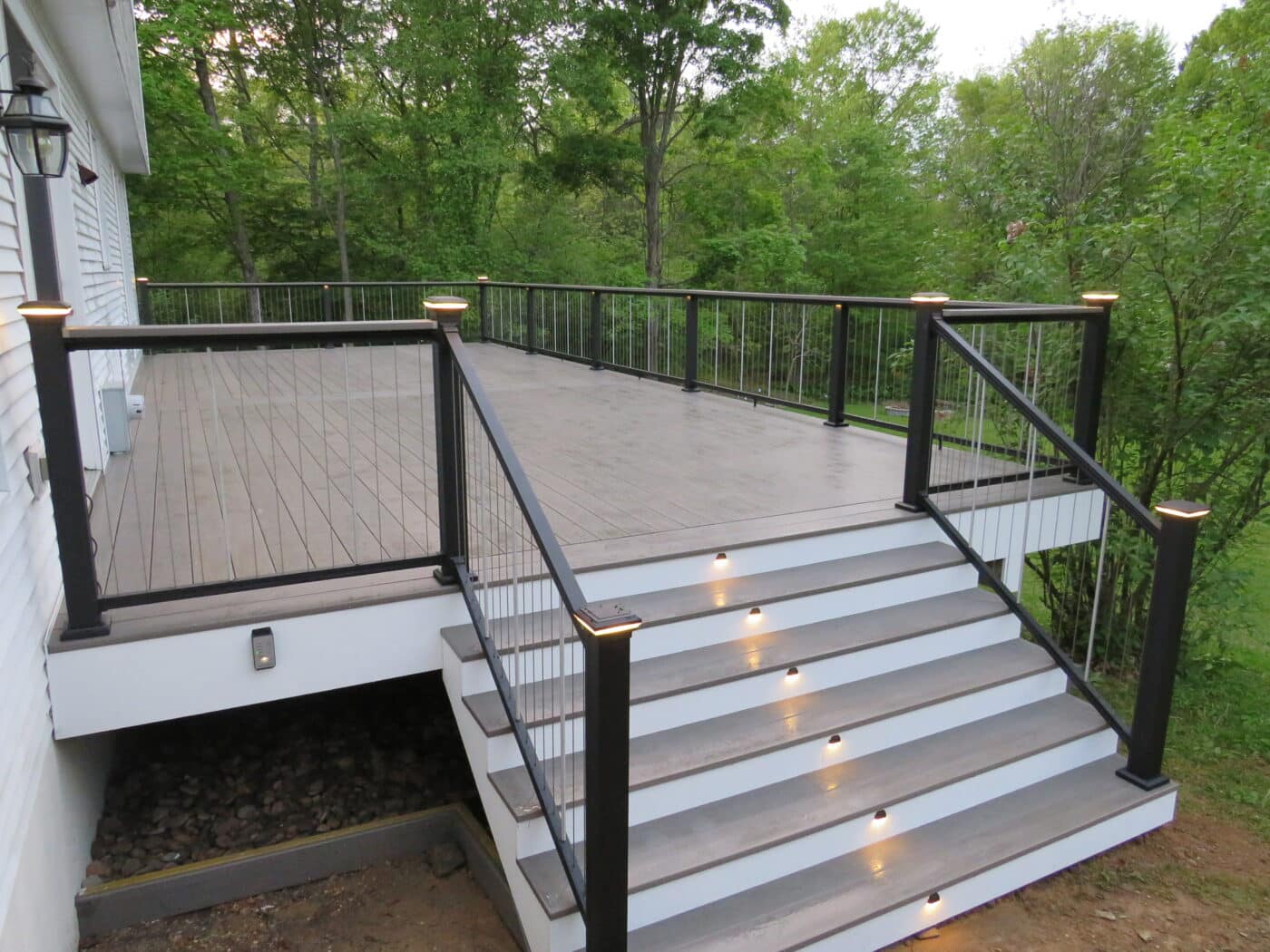
Deck lighting is an aesthetically pleasing lighting solution for your deck. You can install deck lighting directly into stairs, on the posts, under the railing, or directly into the railing post cap. The deck below, located in Danville, uses downward-facing accent lights on the stairs and the middle railing posts. The end posts feature decorative post cap lights with a flat top. The wires for the system are within the railing, creating a clean, seamless look.
13. Two tone railing
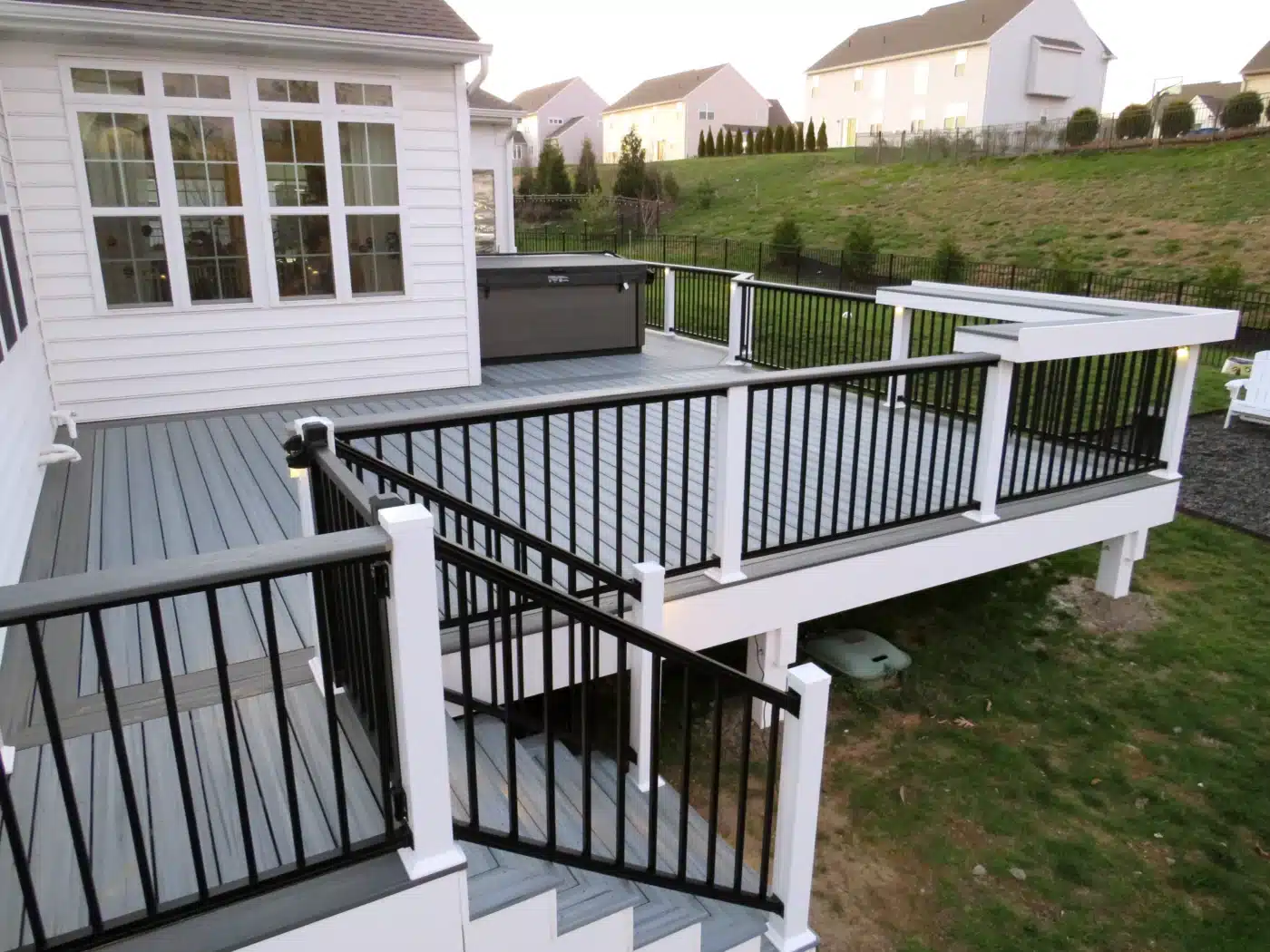
You do not need to use one-color railings. This deck, built-in Mechanicsburg, features a Chesapeake series railing paired with white vinyl railing posts. You can combine many different colors and deck railing ideas to create a truly unique outdoor living space.
